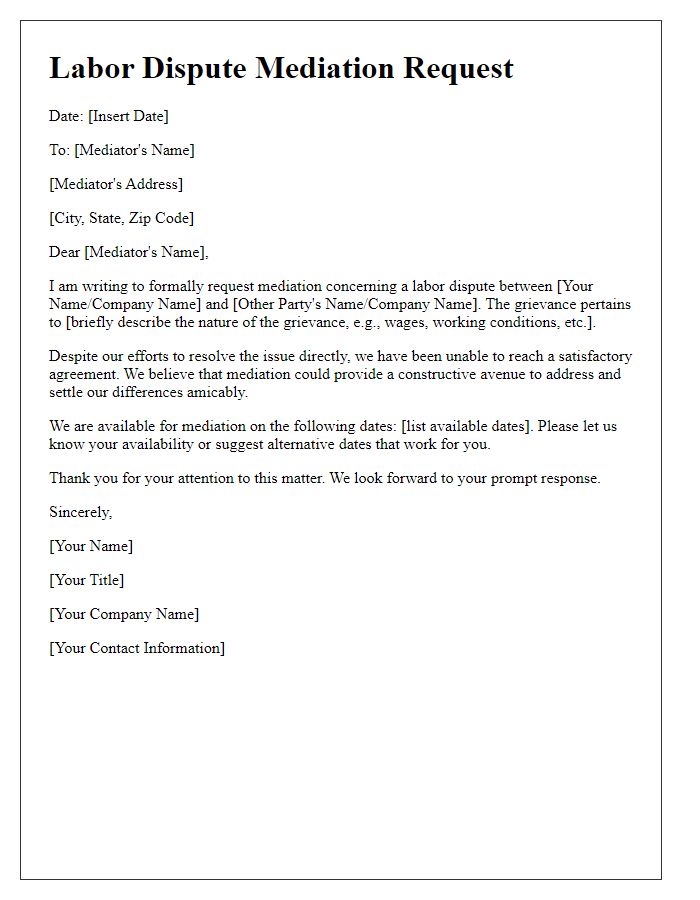Navigating a labor dispute can feel overwhelming, but seeking mediation is a proactive step towards resolution. In this article, we'll explore how a well-crafted letter can effectively communicate your request for mediation, setting the stage for constructive dialogue. We'll break down the essential components of your letter, ensuring it resonates with the recipient and highlights the importance of collaboration. So, let's dive in and learn how to create a compelling request that paves the way for a smoother resolution!

Clear Subject Line
Labor dispute mediation requests typically require a formal tone, a clear subject line, and specific details outlining the nature of the dispute. A well-structured request can enhance clarity and facilitate a timely response. Subject: Request for Mediation in Labor Dispute Over Contract Negotiations This email conveys the need for mediation assistance in an ongoing conflict involving contract negotiations between the employees represented by the [Union Name] and the management of [Company Name]. Significant issues include wage discrepancies, unclear terms of employment, and inadequate working conditions. Given the complexity and sensitivity of the matter, mediation can provide a neutral ground for both parties to reach a resolution while promoting effective communication and understanding. Timely involvement is crucial to prevent escalation and to ensure that all employees, approximately [number] affected, can continue their work under mutually beneficial agreements. Please advise on available mediation dates and any necessary preparation steps.
Employee and Employer Information
A labor dispute mediation request serves to facilitate communication between employees and employers during conflicts. This often involves various details: employee information (name, job title, employee ID number, contact information) allows identification and context of the dispute. Employer information (company name, contact person, company address) represents the organizational side of the conflict. Clear articulation of the dispute, including specific dates (such as the incident date), documented grievances (such as wage issues or working conditions), and desired outcomes can significantly enhance the mediation process efficiency. Establishing a timeline of events leading to the dispute aids mediators in understanding the context and urgency. Providing evidence (emails, witness statements, policy manuals) strengthens the request, emphasizing the necessity for resolution.
Detailed Description of Dispute
The ongoing labor dispute at the manufacturing facility in Springfield, Missouri, involves multiple allegations of unfair labor practices by the management. Employees claim that their rights to organize and negotiate collectively under the National Labor Relations Act have been undermined since March 2023 when significant changes to the payroll system were implemented without proper consultation. Concerns have also been raised about unsafe working conditions, primarily related to inadequate ventilation and exposure to hazardous materials, reported during inspections in June and August 2023. Additionally, employees have voiced grievances over arbitrary disciplinary actions which are perceived as retaliatory measures against those advocating for improved workplace policies. Over 150 employees have signed petitions expressing their desire for mediation to resolve these issues. The absence of constructive dialogue has created a hostile environment, leading to increased tensions between the workforce and management, ultimately impacting productivity and morale.
Requested Resolution
Labor disputes often arise in industrial settings, leading to a need for mediation to resolve conflicts between employees and employers. Mediation aims to foster communication and understanding, identifying solutions that benefit both parties. An effective resolution may involve job security, wage adjustments, or improved working conditions. In 2022, the U.S. saw an increase in labor disputes, underscoring the importance of mediator involvement. A structured mediation process typically ensures neutrality, guiding discussions on critical issues such as employee rights, contract terms, and grievance procedures. The outcomes of successful mediations can lead to effective labor agreements that enhance workplace harmony and productivity.
Contact Information and Availability
Requesting labor dispute mediation involves crucial elements such as contact details and schedules. Labor Dispute Resolution Centers, like the Federal Mediation and Conciliation Service (FMCS), manage negotiations. Typically, include primary contact information: name, title, organization, phone number, and email address. Specific availability times solidify the request; suggest multiple dates and times to accommodate all parties involved. Remember to clarify the dispute context for a more effective mediation process, including a brief description of the issues at stake. Utilize precise language to ensure clarity and openness in communication for timely resolution.
Letter Template For Request Labor Dispute Mediation Samples
Letter template of labor dispute mediation request for specific issue resolution

Letter template of labor dispute mediation request for management and employee dialogue

Letter template of labor dispute mediation request to address contract violations

Letter template of labor dispute mediation request for wage disagreement settlement

Letter template of labor dispute mediation request focusing on workplace safety concerns

Letter template of labor dispute mediation request to improve communication between parties

Letter template of labor dispute mediation request involving collective bargaining negotiations

Letter template of labor dispute mediation request for grievance settlement process

Letter template of labor dispute mediation request to resolve harassment allegations





Comments